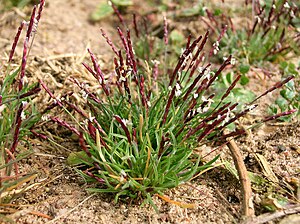Sand dwarf grass
| Sand dwarf grass | ||||||||||||
|---|---|---|---|---|---|---|---|---|---|---|---|---|

Sand dwarf grass ( Mibora minima ) |
||||||||||||
| Systematics | ||||||||||||
|
||||||||||||
| Scientific name | ||||||||||||
| Mibora minima | ||||||||||||
| ( L. ) Desv. |
The sand dwarf grass ( Mibora minima ) is one of two species of the plant genus dwarf grass ( Mibora ) within the sweet grass family (Poaceae).
description
Vegetative characteristics
The sand dwarf grass is an annual herbaceous plant that reaches stature heights of only 2 to 10, rarely 15 centimeters. This grass grows in clusters. The upright, thread-like, unbranched, smooth and bare stalks have two to three knots .
The ligule is a 1 millimeter long collar-shaped, membranous border. The simple leaf blade is 1 to 2, rarely 5 inches long and about 0.5 millimeters wide.
Generative characteristics
The flowering period extends from February to May. The spike-shaped, upright, racemose inflorescence is 0.5 to 2 centimeters long, about 1 millimeter wide and usually purple in color. She is. The spikelets sit in two rows on the winding main axis. The spikelets are single-flowered, 1.8 to 3 millimeters long, at the upper end as if cut off. The glumes are glabrous. The lemma is short and densely hairy.
The number of chromosomes is 2n = 14.
ecology
The sand dwarf grass germinates in late summer and is planted very soon. During the flowering period, which can begin as early as December if the weather is favorable, several hundred stalks will emerge from a single tuft. At the beginning of the anthesis they are only 3 to 5 centimeters high, but grow to heights of 10 or 15 centimeters when the fruit is ripe. Due to the regrowth in the tuft, it then usually continues to bloom until March or April. A well-trained plant can produce around 4,000 to 5,000 fruits in total. Therefore, the sand dwarf grass can sometimes appear in bulk.

Occurrence
The main distribution area of the sand dwarf grass is Western Europe and ranges from Portugal and Spain to France , Great Britain , the Netherlands , Belgium , Northern Italy and southwest Germany . It occurs in Morocco and Algeria , the Czech Republic , Ukraine and the Baltic States . It is seldom carried off and then occurs inconsistently.
In Germany, the sand dwarf grass is very rare and endangered (Red List 2). It occurs mainly in the sandy areas of the Hessian Rhine Plain and Lower Main Plain .
It thrives on dry, lime and humus poor, neutral to moderately acidic, loose, loamy or pure sandy soils in humid-winter-mild climates . It occurs on sand broke and in silver grasslands (order Corynephoretalia). In southern Europe, it grows in therophytes - companies mostly on Steingrusböden .
Taxonomy
The first publication took place under the name ( Basionym ) Agrostis minima by Carl von Linné . Other synonyms for Mibora minima (L.) Desv. are: Poa minima (L.) Stokes , Chamagrostis minima (L.) Borkh. , Sturmia minima (L.) Hoppe , Mibora verna P.Beauv.
The generic name Mibora is like numerous other names by Michel Adanson without explanation and probably arbitrarily. The specific epithet minima means 'the smallest' or 'dwarf'.
Systematics
In addition to Mibora minima , the genus Mibora includes a second species:
- Mibora maroccana (Maire) Maire (Syn .: Libyella maroccana Maire ): It occurs in northwestern and western Morocco. Mibora minima does not occur in Morocco.
literature
- Hans Joachim Conert: Mibora . In: Gustav Hegi : Illustrated flora of Central Europe. 3rd edition, Volume I, Part 3, Verlag Paul Parey, Berlin, Hamburg, 1987, ISBN 3-489-52220-6 , pp. 206-215.
Individual evidence
- ↑ a b Erich Oberdorfer : Plant-sociological excursion flora for Germany and neighboring areas . With the collaboration of Angelika Schwabe and Theo Müller. 8th, heavily revised and expanded edition. Eugen Ulmer, Stuttgart (Hohenheim) 2001, ISBN 3-8001-3131-5 , pp. 259 .
- ↑ a b c d Rafaël Govaerts (Ed.): Mibora. In: World Checklist of Selected Plant Families (WCSP) - The Board of Trustees of the Royal Botanic Gardens, Kew . Retrieved August 30, 2018.
- ↑ Mibora minima (L.) Desv., Sand dwarf grass. In: FloraWeb.de.
Web links
- Mibora minima (L.) Desv., Sand dwarf grass. In: FloraWeb.de.
- Sand dwarf grass . In: BiolFlor, the database of biological-ecological characteristics of the flora of Germany.
- Thomas Meyer: Data sheet with identification key and photos at Flora-de: Flora von Deutschland (old name of the website: Flowers in Swabia ).

